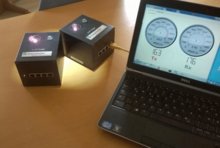Li-Fi

Li-Fi ( English light fidelity ) is an optical wireless technology for data transmission. In contrast to WLAN or other radio technologies, Li-Fi works with the spectrum of light - more precisely with visible light or infrared radiation . Li-Fi is a term that, like Wi-Fi, can be derived from high-fidelity (Hi-Fi for short). The term was coined in 2011 by Harald Haas during a TED conference.
History and state of research
In October 2011, four founding members, the Norwegian IBSENtelecom , the Israeli-American Supreme Architecture , TriLumina (USA) and the Fraunhofer Institute for Photonic Microsystems agreed to form a Li-Fi consortium to promote this standard.
By switching special light-emitting diodes (LEDs) on and off, high data transmission rates can be achieved for close-range optical communication : in 2013, 10 gigabits per second were achieved in the laboratory . Photodiodes act as receivers , with which the light signals are converted into electrical impulses. In the meantime, speeds of around 224 gigabits per second have already been achieved under laboratory conditions.
Oledcomm presented the first Li-Fi compatible mobile phone at the Consumer Electronics Show 2014.
At the end of 2015, Harald Haas presented an improved and more efficient variant of Li-Fi, in which a photovoltaic cell is used to collect and further process the light signals. With this version, energy is now also recovered and new application possibilities are created.
The Fraunhofer IPMS in Dresden has been developing solutions for industrial data transmission that allow real-time transmission since 2016 .
Advantages and disadvantages
In comparison to radio transmission, a larger bandwidth is available for optical transmission , which theoretically allows a higher number of data channels in the same space. In addition, the transmission method can also be used in areas where radio signals can be problematic due to electromagnetic compatibility , such as in aircraft or hospitals. Furthermore, the use of optical transmission is more secure, since an attacker would have to have physical access to the light source in order to intercept or manipulate data packets.
In contrast to radio systems, optical transmission usually only allows direct data transmission on sight and data transmission through house walls, for example, is not possible. This may make it necessary to install stationary receiving and transmitting stations.
See also
Web links
- Lificonsortium
- Definition in search networking
- lifi-technik.de (web archive)
Individual evidence
- ↑ press release
- ↑ Dottech
- ↑ Engadget
- ↑ Dunja Koelwel: Real-time Li-Fi for Industry 4.0. September 7, 2016, accessed on February 5, 2020 (German).